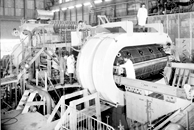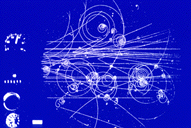


The 88 inch cyclotron at Berkeley
The Gargamelle heavy liquid bubble chamber at CERN.
Production of particle in the first CERN liquid hydrogen bubble chamber .
The Accelerator Era
Pioneer machines
By the 1930s, after the invention of the cyclotron by Ernest Lawrence, it was clear that accelerators were the way forward if physicists wanted to go deeper in to the structure of matter.
Initially the USA led the way: such machines were just too big and expensive for any European country to build alone. But in 1954, European physicists decided to create in Geneva, Switzerland, a central, European laboratory, that they called CERN (Conseil Europ�en pour la Recherche Nucl�aire). Since then, CERN has played a major role in most technical and scientific developments in High Energy Physics.
From the early one-magnet cyclotrons and betatrons which could accelerate protons and electrons, respectively, up to some tens of MeV in energy, the new "doughnut-shaped" synchrotron evolved, able to accelerate both types of particle up into the GeV energy range. By the 1950s, using a new focussing technique, machines were pushing up to around 30 GeV.
From then on, through into the early 1970s, several major steps forward in the search for the basic structure of matter were achieved. An avalanche of new particles was found, thanks to the successful integration of powerful accelerators (like the 28 GeV Proton Synchrotron (PS) at CERN and the 33 GeV Alternating Gradient Synchrotron (AGS) at Brookhaven) and a new, effective particle detector, the bubble chamber.
|
(The
Accelerator Era - page 1 of 4)
| Next > |


